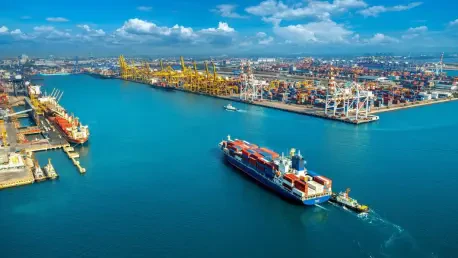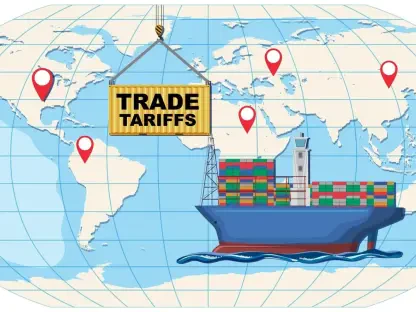The maritime industry in the United States stands at a critical juncture as recent legislative changes under President Trump’s administration reshape the financial landscape for port operations, creating uncertainty for many. The One Big Beautiful Bill Act, signed into law in July, has rescinded $60 million in unobligated funds previously allocated to the Environmental Protection Agency (EPA) for environmental initiatives under the Inflation Reduction Act. This move directly impacts the Diesel Emissions Reduction Act (DERA), a federal program that has been instrumental for ports since 2008 in funding projects aimed at curbing greenhouse gas emissions. Major ports across the nation, from Los Angeles to New York, have relied on these grants to modernize equipment and adopt cleaner technologies. As this funding diminishes, a pressing question emerges about the ability of these vital infrastructure hubs to sustain their environmental commitments. This article explores the immediate effects, long-term challenges, and adaptive strategies of U.S. ports navigating this significant policy shift.
Unpacking the Legislation and Its Targets
The One Big Beautiful Bill Act represents a notable pivot in federal funding priorities, targeting unobligated resources meant for environmental programs managed by the EPA. Specifically, the $60 million cut affects the DERA program, which has long supported ports in their efforts to reduce diesel emissions through equipment upgrades. For instance, substantial grants have enabled the transition to electric alternatives for drayage trucks and gantry cranes, significantly lowering the carbon footprint of port operations. The Port of Los Angeles, a leader in sustainability, benefited from a $2 million grant a few years ago to implement electric locomotive technology. With this financial support now at risk, port authorities face the daunting task of maintaining momentum in their green initiatives without a reliable federal safety net. The broader implications of this legislation signal a potential shift in how environmental goals are prioritized at the national level, leaving ports to reassess their strategies.
Beyond the immediate financial hit, the legislation introduces a layer of uncertainty about the federal government’s commitment to port sustainability. Historically, DERA funding has been a cornerstone for projects that align with national goals to combat climate change, providing ports with the means to replace outdated, high-emission equipment with cleaner alternatives. The rescission of these funds, while not affecting completed projects, halts the pipeline for future grants that many ports had anticipated for upcoming upgrades. This policy change challenges the operational planning of port authorities, who must now contend with the possibility that federal backing for emission reduction may not be as robust in the coming years. As a result, the focus shifts to how these critical trade gateways can adapt to a landscape where federal environmental support is no longer guaranteed, pushing innovation and resourcefulness to the forefront of their agendas.
Short-Term Stability Amidst Funding Reductions
Surprisingly, the immediate fallout from the $60 million funding cut appears minimal for many major U.S. ports. Several key facilities, including the Port of Oakland and the Georgia Ports Authority, currently have no active DERA grant applications pending, meaning their day-to-day operations remain unaffected by the rescission. Similarly, North Carolina Ports have completed their most recent DERA-funded projects and secured full reimbursements, shielding them from immediate financial strain. This short-term resilience is largely due to the timing of grant cycles and the fact that many ports had already utilized or secured their allocations before the legislative change took effect. Additionally, some ports have diversified their funding streams, mitigating the impact of losing federal support. This unexpected stability offers a temporary buffer, allowing port authorities to maintain current operations without significant disruption despite the federal policy shift.
However, this apparent calm masks underlying vulnerabilities that vary by port. While some facilities are unaffected due to the absence of active projects, others have leaned on alternative funding mechanisms to cushion the blow. The Port of New York and New Jersey, for instance, taps into the Congestion Mitigation and Air Quality Improvement program as a backup, ensuring that ongoing emission reduction efforts continue unabated. This strategic foresight in securing diverse financial resources highlights a critical difference among ports—those with robust contingency plans are better positioned to weather the storm of federal cuts. Nevertheless, even for these ports, the reliance on alternative programs is not a complete solution, as such funds often come with different restrictions or smaller budgets compared to DERA grants. The short-term stability, while reassuring, underscores the need for a deeper examination of how ports can sustain progress without consistent federal backing.
Future Challenges for Sustainable Operations
Looking beyond the immediate horizon, the potential elimination of future DERA funding rounds poses a significant threat to the long-term sustainability goals of U.S. ports. Facilities like the Northwest Seaport Alliance (NWSA), which recently utilized a $900,000 grant to replace aging drayage trucks, express deep concern over the availability of future federal support. Similarly, PhilaPort, having relied on past grants to introduce electric yard tractors, worries about the financial feasibility of continuing such initiatives without a steady stream of DERA funds. The uncertainty is further amplified by delays in new grant agreements from the U.S. Department of Transportation, creating a bottleneck that could stall planned projects. As ports strive to meet stringent emission reduction targets, the looming gap in federal resources raises critical questions about how they will fund the transition to cleaner technologies over the next several years.
Moreover, the loss of DERA funding threatens to derail the broader national push for greener port operations, which have been pivotal in reducing diesel emissions across the supply chain. Ports have historically used these grants to cover substantial portions of project costs, often offsetting expenses that would otherwise be prohibitive. Without this support, the pace of adopting electric or low-emission equipment could slow dramatically, potentially undermining years of environmental progress. The challenge is particularly acute for ports with ambitious sustainability agendas, as they must now weigh the cost of innovation against operational budgets already stretched thin. While some may argue that private investment could fill the void, the scale and consistency of federal grants are hard to replicate, leaving port authorities to grapple with a future where environmental priorities might take a backseat to immediate financial pressures.
Regional Variations in Coping Mechanisms
Examining the impact of funding cuts reveals distinct regional differences among U.S. ports, shaped by historical funding patterns and local resources. West Coast giants like the Port of Los Angeles and the Port of Long Beach appear better insulated due to substantial DERA grants received in prior years, which supported projects now completed. These ports have leveraged past funding to establish a foundation of cleaner technologies, positioning them to withstand the current cuts with less immediate concern. However, this advantage is not universal, as their future projects still hinge on securing new financial support. The regional disparity becomes evident when contrasting their situation with smaller or less-funded ports that lack such a buffer, illustrating how past federal investment has created uneven resilience across the country’s port network.
In contrast, East Coast ports like PhilaPort face heightened challenges due to more limited resources and greater dependency on federal grants as independent state agencies. Having benefited from past DERA allocations, such as a $598,200 grant for electric equipment a few years back, PhilaPort now voices apprehension about sustaining clean port planning without similar support moving forward. This regional variation underscores a broader trend: ports with fewer alternative funding options or smaller operational budgets are more vulnerable to federal policy shifts. The disparity also highlights differing capacities to adapt, as West Coast ports may have more access to state or private resources compared to their East Coast counterparts. As these differences play out, the ability of ports to maintain environmental progress will likely depend on localized strategies tailored to their unique financial and operational contexts.
Navigating a Path Forward with Alternative Resources
As federal funding for environmental initiatives wanes, U.S. ports are compelled to explore alternative resources to sustain their green projects. Some, like the Port of New York and New Jersey, have already integrated backup programs into their financial planning, ensuring that truck replacement and emission reduction efforts continue despite the DERA cuts. These alternative sources, while helpful, often come with limitations in scope or availability, making them an imperfect substitute for the targeted support of federal grants. Nevertheless, the proactive approach of certain ports in diversifying their funding portfolios serves as a model for others facing similar challenges. The key lies in identifying and securing resources that align with long-term sustainability goals, even if they require navigating complex application processes or forming new partnerships.
Equally important is the role of collaboration with governmental and industry stakeholders to bridge the funding gap. Many port authorities remain hopeful about working with congressional delegations to advocate for restored or new federal support, recognizing that sustained environmental progress requires a collective effort. Additionally, exploring state-level grants or private sector investments could provide a lifeline for ports struggling to replace the scale of DERA funding. The challenge, however, is ensuring that these alternatives offer the reliability and magnitude needed to support capital-intensive projects like equipment electrification. As ports chart this uncertain path, the focus must remain on innovative solutions and strategic alliances that can uphold their commitment to reducing emissions. Reflecting on past adaptations, it’s evident that resilience was built through foresight and flexibility, lessons that guided ports through previous fiscal constraints and will continue to inform their strategies in addressing these recent legislative changes.









